The Measurement of Residual Stress using Laboratory Based X-Ray Diffraction Instruments; the Positives, the Pitfalls and a Round Robin
National Physical Laboratory, NPL, Teddington, UK
September 2023
Chair: Judith Shackleton, Rolls-Royce, Civil Large Engines, (Retired)
A one day workshop which included the following topics:.
- The basic principles of crystallography and of the laboratory based X-ray diffraction (XRD) method
- Advantages and limitations of the method
- Measurement of awkward samples including curved, large ones and anisotropic materials
- Elastic constants, after all, we measure strain, not stress
- Methods layer removal which do not introduce additional stresses
There was an instrument Manufacturer's forum and live demonstrations
A programme of Round Robin XRD residual stress measurements was discussed at the meeting.
The results from the recent EASI-STRESSers Round Robin were described as well as a comparison with hole drilling techniques.
There was an instrument manufacturer's forum with live demonstrations of portable residual stress diffractometers.
A Round Robin took place to test the reproducibility XRD method with a wide a range of instruments and participants.
Speakers
• Tony Fry, NPL, Teddington.
• Dr Joe Kelleher, ISIS Pulsed Neutron & Muon Source, Harwell Campus, Didcot.
• Prof. John Bouchard, Stress Space, Harwell Campus, Didcot.
• Dr Ioannis Violatos, Materials Modelling Theme Lead, Advanced Forming Research Centre, Strathclyde.
• Prof. Matthew Roy, Department of Engineering, University of Manchester.
• Dr Jeferson Araújo de Oliveira, Residual Stress Measurement Services, StressMap, Open University, UK.
• Judith Shackleton, Rolls-Royce, Civil Large Engines, (Retired).
Manufacturers
Bruker
Proto
Pulsetec
Quantum Design
Stresstech
Presentations
Introduction to the National Physical Laboratory
Tony Fry, NPL
A brief introduction to the activities of the National Physical Laboratory
NPL is the UK’s National Measurement Institute and was founded in 1900 for "standardising and verifying instruments, for testing materials, and for the determination of physical constants." We are one of the oldest standardising laboratories in the world. Since its establishment, the research work at NPL has included all branches of physics, light, electricity and magnetism, radio communication, engineering, metallurgy, aeronautics and ship design. Some of the world’s most significant innovations have origins at NPL, including radar; packet switching, the forebearer of the internet; the ACE computer; and the caesium atomic clock. One route to impact and improvement of the quality of measurements in industry is through training and the production of Measurement Best Practice Guides. This presentation will outline the core roll of NPL and provide an overview of the history of the XRD Residual Stress Best Practice Guide and plans for future developments of this guide.
Elastic Constants
Dr Joe Kelleher, ISIS Pulsed Neutron & Muon Source, Harwell Campus, Didcot
Material performance and structural integrity is usually best understood by considering values of stress in the material. However, the atomic lattice spacings measured by X-ray and neutron diffraction are more directly related to elastic strain. Elastic constants for the material of interest, which quantify the relationship between stress and strain, are therefore required when using diffraction methods to measure residual or applied stress. Experimental methods to measure elastic constants are described, along with the various ways they may be specified and quoted in the scientific literature. Moreover, the elastic properties of materials are often of research interest in their own right. Physical origins are considered for the relationship between the elastic constants used for diffraction and the macroscopic elastic quantities familiar in engineering like the Young's modulus and Poisson's ratio. The anisotropy of the single crystal grains within a microstructure can cause the hkl-specific diffraction elastic constants to differ substantially from those that might be expected from just considering the bulk elastic behaviour, and examples of these effects in common engineering materials are considered.
Measurement of Awkward Components
Prof John Bouchard, Stress-Space Ltd
Awkward components can be defined as those having a global shape and/or local geometric surface form that can compromise accurate positioning or limit the X-ray measurement optics that can be applied. This classification includes components that are physically too large or too heavy to measure using a typical laboratory-based X-ray diffractometer, and structures that cannot be dismantled or are situated in hostile environments. The talk will present some measurement strategies for dealing with such awkward components, including a laser-guided XRD measurement system that maps the detailed surface form of parts large and small and accurately positions XRD measurements in both laboratory and field application contexts. The talk will be illustrated by recent measurements on large samples made using the laser guided system described.
Materials Modelling
Dr Ioannis Violatos, Advanced Forming Research Centre, Strathclyde
Determination of residual stresses throughout the manufacturing route of high value engineering products is particularly challenging. There are inherit limitations with the measurement techniques for residual stresses and a number of uncertainties associated with the condition of the material and the measurement procedures for in-situ or ex-situ investigations. X-ray diffraction is the industry's gold standard, because it can provide a fast, accurate, and reliable non-destructive assessment of in-plane surface stresses. These information can be used as part of i) a design and optimisation process to address distortion and/or material failures in manufacturing, ii) a metric for the quality of manufacturing and the integrity of a product, and iii) a digital passport for a product and its manufacturing route. Thus, x-ray diffraction is indispensable in the assessment of residual stresses and it can complement other techniques to synthesize the full stress state of a material/product and gain an invaluable insight about a processing step. This talk will attempt to provide a critical comparison between x-ray diffraction and other residual stress measurement techniques within the broader context of manufacturing through case studies on forging, welding, machining and additive manufacturing of metallic materials, showcasing challenges and good practises in the assessment of residual stresses.
How the X-ray Diffraction Based Method Works and Some Crystallography
Judith Shackleton, Rolls-Royce plc (Retired)
This talk will cover some basic crystallography including, crystal systems, Bravais lattices, Miller indices and Bragg’s Law as this information is required to specify measurements. We will also describe, briefly how the sin2psi method works, its advantages and disadvantages.
Laboratory XRD determination of residual stress of EASI-STRESS benchmarks
Prof. Matthew Roy, Department Of Engineering , University of Manchester
The recent EASI-STRESS programme (www.easi-stress.eu) aims to improve industrial user access to non-destructive diffraction techniques such as high energy synchrotron X-ray and neutron diffraction. As part of this initiative, a series of benchmarks were developed such that they could be subjected to the widest range of residual stress measurement techniques. One of these benchmarks was configured and measured by three different practitioners of commercial, laboratory-based X-ray diffraction with the sin2psi technique. It was found that while planar stresses could be found such that the magnitudes of peak tension and compression as well as errors all agreed, repeatable location of measurement sites was challenging. A description of the ferritic steel benchmark used will be described, the protocol employed for both performing and reporting measurements, and finally the results will be presented in the context of measurement standardization.
Depth profiling of residual stresses using X-ray diffraction – A practical review
Dr Jeferson Araújo de Oliveira, Residual Stress Measurement Services, StressMap, Open University, UK
In many engineering applications, the variation of residual stresses with depth is a key aspect for the accuracy of structural integrity assessments. Laboratory X-ray diffraction is normally limited to surface measurements ~5-30 µm , depending on the material and measurement conditions.To overcome this limitation and assess a residual stress depth profile, thin layers of material need to be removed from the region of interest. This presentation will review the practical aspects of this approach, including the techniques for material removal, problems that normally occur in theory and practice and how we normally overcome or mitigate these challenges.
A New Round Robin
Judith Shackleton, Rolls-Royce plc (Retired)
It's some time since a round robin was undertaken for laboratory based X-ray diffraction residual stress measurements. As these measurements are frequently made on safely critical components it's very important to check the reproducibility across as many laboratories as possible. It's proposed to set up as new test at this meeting. We will consider the sort of samples should which would be most suitable, for example, which alloys, shot peened specimens or bent bars. Suggestions most welcome!
Chair's Summary
The event was well attended with the meeting room completely full. The presentations provided an initial introduction to the measurement method and then elaborated more of the issues and some very nice case studies focussing on different aspects, for example:
• Elastic constants, as we measure strain and calculate the stress using the elastic constant.
• Depth profiling, layer removal, never easy.
• Strain mapping, modern detectors have really enabled mapping.
• Large, awkward shaped samples.
• Comparison of different measurement methods for surface and near surface stresses .
The challenges and results from a previous Round Robin study, using a sectioned, bent bar were also described.
A Manufactures forum was also included with informative descriptions of both dedicated and multipurpose instruments.
The live demos were very beneficial and really showcased the development in the instrumentation and equipment which the delegates really appreciated. Two of the instruments were actually switched on and were producing X-rays, though well shielded. Many thanks to the National Physical Laboratory’s Health Physicist for ensuring that these instruments could be used “live”.
There were some good discussions throughout the day and we have received very positive feedback. The round robin discussion at the end was particularly interesting and National Physical Laboratory said that they would be happy to be involved. The discussions centred around the type of samples which would be suitable,
• Shot peened or ring and plug?
• Which metals/alloys, titanium 64? Aluminium? Ferrite?
• Geometry, Only flat samples? Or curved ones? Rods? Ball bearings?
Funding is an obvious issue and possible sources were discussed, always difficult in these times. The meeting ended though with lots of energy and enthusiasm and we hope to keep the ball rolling and organise the Round Robin over the next few months.
`Very good workshop explaining the fundamentals and some of the biggest issues of residual stress measurement. Held with a relatively small number of participants so everyone had a chance to discuss their questions and measurement issues. Real experts were involved providing high quality and really relevant lectures. Also a lot of companies focused on residual stress measurement joined as exhibitors and they also participated on the lectures. They were kind and willing to share a lot of their know-how related to measurement troubleshooting.'
Libor Trško
University of Žilina, Slovak Republic
'Really enjoyed the day, great workshop overall and did cover a lot in one day. '
Remi Romac
Airbus
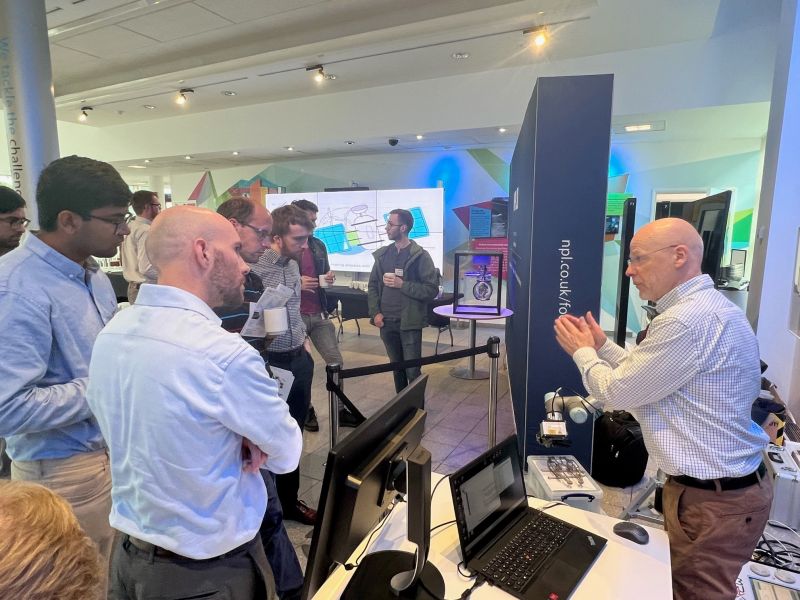
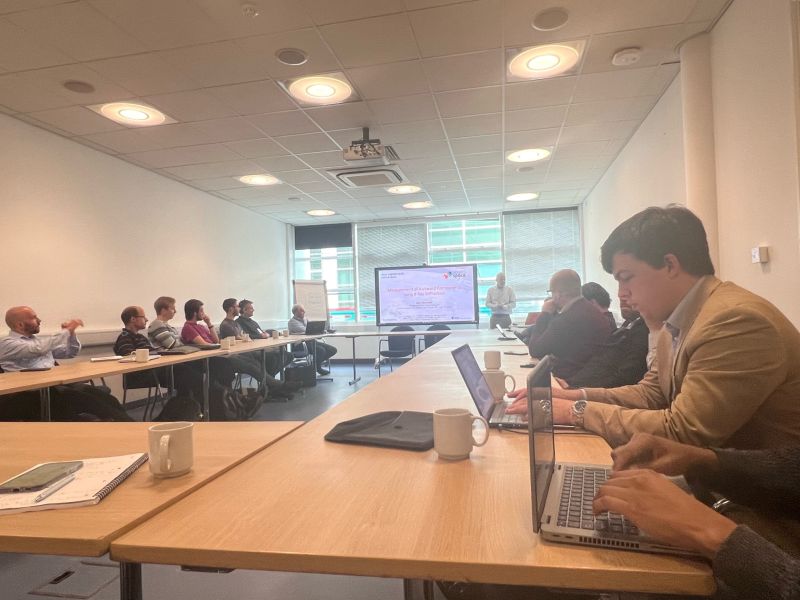
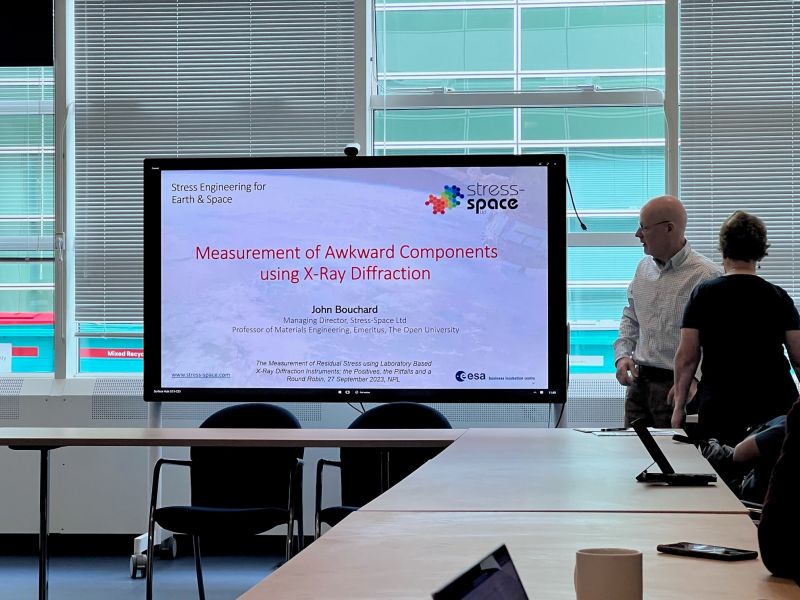
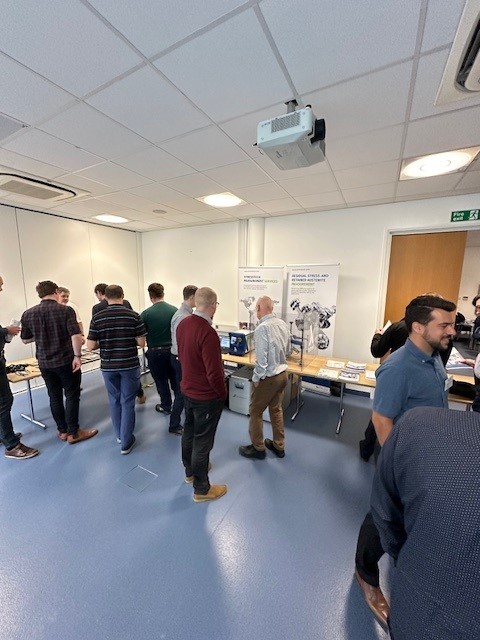

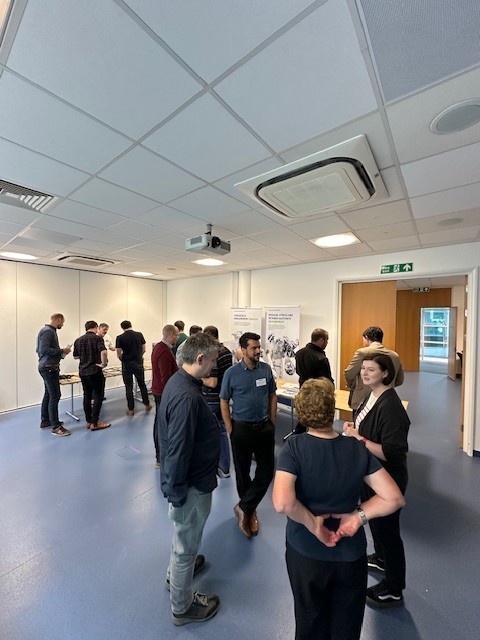
Presentations

Programme
Judith Shackleton, Rolls-Royce Civil Large Engines,
Derby, UK. (Retired)

Introduction to the National Physical Laboratory
Tony Fry, NPL

Elastic Constants
Dr Joe Kellerher, ISIS Pulsed Neutron & Muon Source, Harwell Campus, Didcot

Measurement of Awkward Components
Prof John Bouchard
Stress-Space Ltd

How the X-ray Diffraction Based Method Works and Some Crystallography
Judith Shackleton, Rolls-Royce Civil Large Engines,
Derby, UK. (Retired)

Laboratory XRD determination of residual stress of EASI-STRESS benchmarks
Prof. Matthew Roy
Department Of Engineering , University of Manchester

Depth profiling of residual stresses using X-ray diffraction – A practical review
Dr Jeferson Araújo de Oliveira
Residual Stress Measurement Services, StressMap, Open University, UK

A New Round Robin
Judith Shackleton
Rolls-Royce plc (Retired)
Manufacturers
Upcoming Events
For full details of all upcoming conferences, workshops, courses and more
Ask the Experts
If you have a specific question about strain measurement, a particular technique or application area, or want to find out which of the BSSM Corporate Members might be able to help
Do you have ideas for future events?
If you have any feedback or ideas for future BSSM events you'd like to see or be involved in please get in touch





